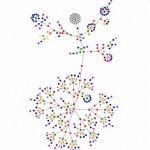“There is no reality above and beyond that created by the integration of all consciousness” (Talbot, 1991, p. 160).
We exist in the era of instant – instant coffee, instant food, and even on a recent episode of “Dancing with the Stars” we witnessed “instant dancing.” Behaviorally, we are in a mode of “instant gratification” in which we expect our desires to manifest immediately. But if we take a broader view of events we realize that our eventual success, project completion, or object of desire may not be at our finger tips because we are enmeshed in a vast, dynamic universal web of interconnection. The non-physical realm, or celestial storehouse in which all activity, past, present, and potential exists in a subatomic wave encoding of thought has been termed “The Field.” The background sea of activity that surrounds us exists because all matter (though appearing solid and immutable) is actually nothing more than a mass of electrical charges (McTaggart, 2002). These charges are constantly interacting with one another at a quantum, or subatomic level, leaving a holographic imprint of both the object and the interaction.
If we are indeed one within an intricate web of connection, then perhaps we must be patient for events to occur in our lives – and, we must be more accepting of those things that have already occurred. Zukav (1989) explains that if we simply allow the future to unfold, we would cease to be unhappy and upset when our desires are contrary to expectation. Similarly, Talbot in Holographic Universe describes an Indian mystic’s paradoxical approach to life: “Whatever happens, I don’t mind.” Perhaps relaxation into what is and the cessation of resistance allows us to see more clearly the path that is before us, which permits our desired future to appear in a more expedient fashion. Moreover, negative thought culminates in a mindset of worried paranoia, a constant unease, and a lack of imagination that prevents us from envisioning foreseeable threats and of creating a better future.
When we become anxious at an unwanted turn of events, try some of the following suggestions:
- Calm yourself (through meditation, music, walking, etc). Mental turmoil does little to secure a desired solution, and results in clouding our judgment. Moreover, the mental signals released from such an effort are incoherent (Pearce, 2002). A terrific resource from Han and Nguyen (2006) is titled “Walking Meditation,” a CD premised on the notion that repetitive physical action is a soothing mechanism to our minds.
- Remove your focus from the problem. Engage yourself in an alternate activity, preferably one that involves helping other people. Focus on someone outside yourself removes some of the myopic attention that results in self-pity and depression.
- Envision your desired future. If the Field does indeed encompass an infinite number of possibilities that are culled forth by our focus, then deliberately crafting what we want through intention (while subsequently releasing the outcome) may be a type of mental entrepreneurship.
I love what Byron Katie states with regard to peace of mind:
I am a lover of what is, not because I’m a spiritual person, but because it hurts when I argue with reality. We can know that reality is good just as it is, because when we argue with it, we experience tension and frustration (Katie, 2002).
_____________________________________________________________________________________________
References
Hanh, T. N., & Nguyen, A. H. (2006). Walking Meditation. Canada: Sounds True. Katie, B. (2002). Loving what is: Four questions that can change your life.
McTaggart, L. (2002). The field: The quest for the secret force of the universe. New York, NY: HarperCollinsPublishers.
Pearce, J. C. (2002). The biology of transcendence: A blueprint of the human spirit (p. 150). Rochester, VT: Park Street Press.
Talbot, M. (1991). The Holographic Universe (p. 225). New York, NY: HarperPerennial.
Zukav, G. (1989). The seat of the soul. New York, NY: Simon & Schuster.





Recent Comments